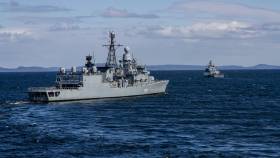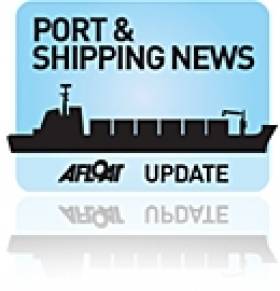Displaying items by tag: German Navy
A German Navy frigate which carried out exercises in Swedish waters has arrived in Dublin Port and will remain docked during the June Bank Holiday weekend, writes Jehan Ashmore.
The 'Bremen' 122 class frigate FGS Augsburg displacing 3,680 tonnes had departed Bremerhaven, though the vessel which is one of eight anti-submarine warfare ships built between 1982 and 1990 is based in Wilmelmshaven.
FGS Augberg is berthed at Dublin's Deep Water Berth where is sited a crane depicting the mural of the late Ronnie Drew, the Irish singer & folk musician best known as a member of the Dubliner's. The Liebherr built crane featured as part of the 'Starboard Home' T.V. documentary which was broadcast last night.
There will be no public visits of the 132m long frigate during its stay in the capital.
In terms of design of the octet class frigates, they are based from the Dutch Navy's 'Kortenaer' class but uses a different propulsion system and hangar lay-out.
FGS Bremen is suited for anti-suface and aircraft warfare and this is reflected in the crew of 202 in addition to 20 personnel involved in aviation.
Among its weapons systems is a single 76 mm OTO-Melara Geschütz gun and 16 NATO Sea Sparrow missiles.
The frigate along with FGS Erfurt auf dem carried out recent rocket exercises off Sundsvall, north of the Swedish capital of Stockholm. Sundsvall is located on the east coast of the Nordic nation and along the Gulf of Bothnia.
It was in much warmer climes in the Meditterranean where FGS Augsburg was deployed to in 2015 along with replenishment ship FGS Berlin as part of the EU led Operation Sophia. The primary role is aimed to neutralise established refugee smuggling routes across the Mediterranean Sea.
The humanitarian mission also involved the participation of the Irish Naval Service. In March of this year it was announced that further deployment of Irish patrol vessels is to end in the EU's large scale effort on migrant rescue operations held off Libya in north Africa.
Instead the focus will be on the use of air patrols and closer co-ordination and co-operation with the Libyan authorities.
German Navy Rocks Boat With Courtesy Flag 'Error'
#CourtesyFlag - An Afloat reader contacted us after spotting the German naval corvette F264 Ludwigshafen am Rhein, currently docked at Sir John Rogerson's Quay in Dublin.
However, he noticed that the ship was flying her Irish courtesy flag on her port yardarm, often considered inferior to the starboard, or 'superior', yardarm, as dictated by flag etiquette for international vessels.
Is this an intentional insult? More likely it's just a clash of cultures, as flag etiquette has no hard or fast rules, and many nations differ as to how their vessels should fly their flags whether in home or foreign waters.
But what do you think? Has the German navy made a massive blunder? Or is it all just a storm in a teacup? (see our facebook page comments below!)
Der Klanger? A German Corvette docks in Dublin but is her Irish Tricolour a 'Faux Pas' on the Liffey? Read more below:
Posted by Afloat Magazine on Saturday, 26 September 2015
Let us know in the comments below too!
#CorkHarbour - Following today's earlier news of a French naval visit to Dun Laoghaire Harbour comes word from TheJournal.ie of a courtesy call by the German navy at Cork Harbour this weekend.
Seven German vessels will be stopping by till Monday 27 April restocking supplies and giving their crews some well earned shore leave.
But they're also sure to pause and reflect on the 100 years since the sinking of the Lusitania by a U-boat representing a very different Germany in the First World War.
Commemorations for those who died in the tragedy began in Cork Harbour on 1 February and will continue till the anniversary on 7 May.
German Navy Training Task Group Visit Dublin Port in between NATO Exercises off Norway and West Africa
#GermanNavy – A German Navy Training Task Group which docked yesterday in Dublin Port in the run-up to the St. Patrick' weekend has completed taking part in a NATO maneuver "Dynamic Goose" in the Norwegian Sea, writes Jehan Ashmore.
To see the route of the Training Task Group including those conducted in the Norwegian Sea (click link for map) . The flotilla of four vessels are making the port of call to Dublin Port until Tuesday and they will not be open to the public.
The largest vessel is Frankfurt am Main (A1412), a Berlin-class group supply vessel. The 174m long auxiliary oiler replenishment (AOR) can also handle containers for military equipment, stores and an aft deck for helicopters.
Accompanying the AOR are three frigates, the Augsberg, Hamburg and Oldenberg and for further details click link in opening paragraph.
Following the Irish visit, the task group are planning to take part in the up-coming maneuver "Obangame Express" in the Gulf of Guinea off the west African state, again refer to map-link above.
Merkel's Navy Visits Dublin Port for St. Patrick's Weekend
#GermanNavy – Following Chancellor Merkel's recent visit to the European People's Party annual congress in the Convention Centre, Dublin, a German Navy task group are visiting downriver in Dublin Port for the St. Patrick's Weekend, writes Jehan Ashmore.
Among the task force group is FGS Frankfurt am Main (A1412), a Berlin-class group fuel-supply vessel or (AOR) which has already docked this morning.
The AOR (auxiliary oiler replenishment) can also handle containers for military stores, equipment and at the stern is a deck for helicopters.
The 174m AOR berthed at the port's deepwater berth along the south quays beyond the MTL Container Terminal, Ringsend. She has visited the capital before having previously docked also at this berth.
Accompanying the AOR is a flotilla of three ships which will be allocated berths elsewhere on the northern quays. They are the Bremen class frigate FGS Augsberg (F213), the Brandenburg class FGS Hamburg (F220) and the smallest of the three frigates, the Braunschweig class FGS Oldenberg (F263).
As previously reported on Afloat.ie, by our Cork Correspondent, a German Navy sail-training vessel, Gorch Foch is also to pay a visit from today and remaining to 29 March. The three-master of 81m in length will be berthed at Cobh Cruise Terminal.
The crew will be happy to welcome the public for "open ship" events on Sunday, 16 March and Sunday, 23 March, from 2 – 5 p.m. All are welcome, admission is free, no prior registration is required.
German Navy Task Force Calls to Capital
#GERMAN NAVY – Three German Navy vessels that forms a task force group docked in Dublin Port this morning for a weekend courtesy call, writes Jehan Ashmore.
Auxiliary tanker FGS Frankfurt Am Main (A1412) berthed in the heart of the port at Alexandra Quay West, close to the East-Link Toll-Lift Bridge. The 174m vessel which displaces over 20,000 tonnes will remain somewhat obscured from view during her port of call due to the surrounding dockland infrastructure.
The Berlin class replenishment vessel and her leadship sister FGS Berlin are the largest units in the German Navy. They not only carry fuel but also handle stores, military equipment, ammunition, medical services and can accommodate helicopters.
Footage above shows the task force departing Portsmouth from a vantage point taken from The Hard that leads into the Hampshire harbour.
Across Alexandra Basin lies the Sachsen class air-defence frigate FGS Hessen (F221) of 5,690 tonnes. The third member of the trio is the 130m Bremen class multi-purpose frigate FGS Emden (F210) of 3,680 tonnes which is moored at an adjacent berth alongside at Ocean Pier.
Unlike the auxiliary the frigates will be more visible from the south quays near the Poolbeg Yacht Boat Club marina at Ringsend.
European Naval Flotilla Docks in Dublin
Of the foursome, only ENS Tasuja is the odd one out, she is a diving and support vessel whereas the rest are all a combination of minehunters / minesweepers. ENS Tasuja is from the Lindormen-class and was built in Denmark in 1977. She is 44.5 meters long, has a maximum speed of 14 knots, and has a crew of 28.
HNoMS Maaloey is an Oksøy-class minehunter which has a catamaran hull constructed of fibre-reinforced plastic which has a very low magnetic signature. She can carry two ROV's and the same number of rigid inflatable boats (RIB).
Above: The Norwegian Navy’s catamaran minehunter HNoMS Maaloey detonates a sea-mine
She is almost identical to the Alta-class leadship HNoMS Alta which provided escort duties during the official state visit of King Harald V and Queen Sonja of Norway, on board the royal yacht K/S Norge in 2006. She arrived in Irish waters, firstly calling to Dun Laoghaire Harbour, where the royal couple boarded the royal yacht at the East Pier. From there she sailed the short distance across the bay to Dublin Port and her last Irish call was to Cork.
ORP Flaming is a mine countermeasures vessel which operates in minesweeping and minehunting. The vessel is designed to trace such devices and make safe fairways for shipping. She can detect anchored mines 1600m from the ship and bottom mines located 600m below the ship's keel. In addition she can lay mines of six different types.
FGS Überherrn is a Kulmbach Class minehunter, in service with the German Navy since commissioning in 1989. She was originally built as a Hameln Class (SM 343) minesweeper by STN Systemtechnik Nord, but was converted to the Kulmbach Class. She has an overall length of 54.4m, a width of 9.2m and a draft of 2.5m and a displacement of 635 tonnes. Armament comprises two, four-cell Stinger missile launchers firing FIM-92 Stinger surface-to-air missiles. There are a crew of 37, which includes four officers, 20 petty officers and 13 ratings.
The flotilla are moored two abreast alongside Sir John Rogersons Quay (berth No. 8), which is located on the south quays between the Samuel Beckett and East-Link Bridges. Of the four naval ships, FGS Überherrn is the first to depart on Sunday, the other vessels are to depart on Monday. The vessels will provide an opportunity to view at close quarters a variety of naval architecture design and navies from northern Europe.
Naval Salvage Tug Docks in Cork City
Built by Schichau Seebeck Werft, Bremerhaven, the 68m vessel has a limited armament capability and a crew of 45. Her main role is as a safety ship for use in submarine training and is equipped for fire-fighting, icebreaking and wreck location duties.
The veteran vessel had called to Dublin Port last weekend while her stay in the southern city will end with a departure scheduled for Monday morning.
Tug-of-War to Visit Capital
She was built in 1967 by Schichau Seebeck Werft, Bremerhaven and the 68m / 23-ft long auxiliary has a limited armament capability and a crew of 45. Employed as safety ship for the submarine training group, she is also equipped for fire-fighting, icebreaking and wreck location duties. The Kiel registered veteran vessel is named after a German island.
All three visiting vessels were to be made open to the public over the weekend while berthed alongside the Deep Water (Coal) Quay downriver of the East-Link Toll-Lift road bridge.
FGS Brandenburg is the leadship of the Type-123 'Brandenburg' class. For a photo of the 4,900 tonnes frigate arriving in the Grand Harbour in Valleta, the capital of Malta (in 2004) click here.
The 20,240 displacement tonnes FGS Berlin is also the leadship of her namesake class of auxiliary fuel replenishment/stores-ship. The 174-metre long Berlin class ship (see photo) also has the capability to convey containers. The last of the trio, FGS Rheinland-Pfalz (photo) is a Bremen class frigate of 3,680 tonnes.
Since the Libyan crisis started in late February, the Maltese capital has been frequently used as a strategic transitional hub-port for naval vessels, including several calls by the UK's Type 22 frigate HMS Cumberland (F85). Earlier this month the Type 42 destroyer HMS York (D98) was also conducted to assist fleeing UK and foreign nationals from Benghazi.
In addition to other navies, Valletta has been used by ferries chartered by governments to assist in the evacuation of thousands of fleeing foreigners, mostly from Europe, though many other emigrants from Africa and Asia remain stranded.






































































